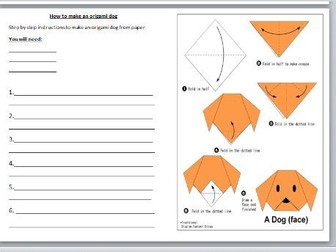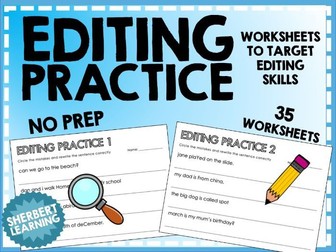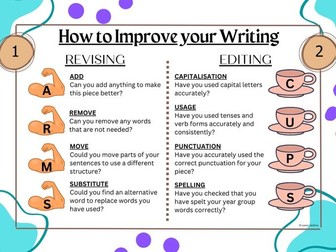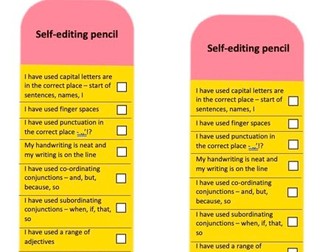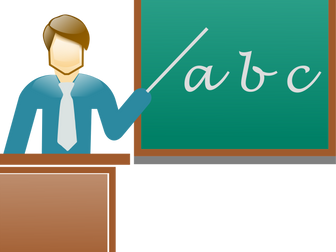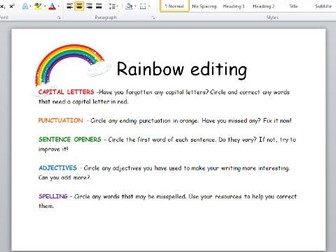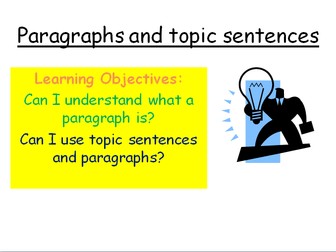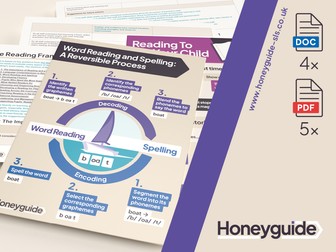
Year 2 Recipes to edit and improve
A complete lesson on editing and improving writing - aimed at Year 2.
Includes a powerpoint outlining the aims and purpose of the lesson, with opportunities to assess where the children are currently at.
Lesson consists of 3 recipes for children to edit and improve - differentiated 3 ways.
BA - simple punctuation to correct
A - Some missing punctuation and repetitive sentence openers
AA - provided with a model text and then blank template to create their own.
Used successfully for lesson obs.
Sale

Editing and improving our work poster
A simple display poster demonstrating how to edit and improve our sentences

Edit and Improve instructions - Higher Order Literacy Task
This worksheet provides a set of poorly written instructions, which the children have the opportunity to evaluate and improve using the given success criteria to help.

Edit and Improve- The Three Little Pigs (SPaG)
Sentences based on the story of ‘The Three Little Pigs’ that need editing and improving.
undefined

Editing / Revising / Proofreading Practice - corrections and improvements NO PREP
EDITING SKILLS PRACTICE
Challenging editing activities for any engaging writing, grammar or spelling program!
Worksheets are intended to get progressively harder for students to apply a range of editing skills and spelling/grammatical knowledge.
→ 35 editing pages
→ Depersonalised editing practice for students to develop their editing skills
→ Variety of activities with different focuses
→ Universal font for any classroom
Targets two types of editing skills
• To identify and correct errors.
• To elaborate and make improvements.
Students must correct
• Punctuation
• Capitalisation
• A range of spelling rules - eg. plurals, contractions
• Tense
Students also must improve and elaborate simple sentences or paragraphs. These sheets can be used to explore adjectives and description, sequencing/transitional words, writing in detail etc.

Improving Writing
As is the writing process, asking children to revise and edit their work can be equally as daunting. It can be hard for a child to know where to begin the revising and editing process. This handy resource will help both teachers and children to start their journey to being even imaginative, creative and fantastic writers!

Improve the sentence
Simple, editable worksheet to help children improve their sentences. Can be adapted to suit the different age requirements. Will also help younger years with copying accurately.

Improve a Sentence - Worksheets
An excellent way to help your students improve their sentences.
The PowerPoint and display materials also give examples.
Fully editable.

Editing pencil checklist
A self-editing checklist for year 2 objectives. Encourages independence to include many features in their writing and also promotes editing and improving their work.

Editing Stations
Ever since I have introduced these editing stations into my lessons for English the quality of editing and improving has increased massively!
Each station has a selection of resources that accompany it. For example, for spelling we have the Year 5/6 spelling words and dictionaries available.

Editing Stations
Slides to support lower KS2 children in editing and improving their writing. To begin the class ‘stops’ at each editing station together and we model how to carry out each activity. As they become more secure and independent, the children can move from one station to the next in groups as a carousel. Easily adapted to different ages.

Improving Sentences Activities
Here is a useful and effective way of teaching children to improve sentences using a colour-coded system - learning about aspects of Grammar and applying them to the writing process. They can also add in aspects that are missing in their own writing which improves the quality and effect. This gives children something concrete to do when editing and improving that is purposeful, clear and fun to do and they love having a special set of pens!
Bundle

Improve your History Lessons Bundle
The resources on sale here are almost every editable general resource I have produced. You can get your class reading through a game, creating a dialogue with characters through text messages, selecting emojis to help with revision, creating timelines, pitching historical events or just watching The Simpsons and making sure they learn.

SPaG - Improve the Sentences
Interactive teaching activity. Each slide contains three simple sentences, which can be improved by adding or changing adjectives and/or adverbs. Underneath each sentence, there is a live text box that can be typed in while the presentation is running. This can be used to model the activity or crowd source ideas. There are supporting worksheets, including editable versions, included.

Rainbow editing - Year 2
A great resource to help children edit and improve their writing. My class have loved this and it has improved the quality of their writing.

Improve Your Writing: Paragraphs and Topic Sentences
A ready to go lesson that teaches students the purpose of paragraphs and topic sentences in a concise 1 hour lesson. Students learn about paragraphing and topic sentences. They then apply their understanding to produce their own letter based on a fictional character (though the activity is adaptable). Resource provided for students to edit and use to identify the topic sentences. Opportunities for peer assessment also included as well as plenaries and clear measurable lesson objectives.

Improving Reading Pack
This Improving Literacy Across Your Setting Bundle contains four editable templates and five beautiful posters that allow you to audit and monitor your reading provision in order to build a strong culture of reading. It’s ideal if you’re a more experienced literacy lead who already understands The Reading Framework guidance, and you just want to investigate the strengths and weaknesses of reading across your setting. While much of the bundle links to teaching in a primary setting (because this is where children learn the skills of reading), it’s also applicable to secondaries and those looking to understand how reading is taught in primary so they can support their secondary students who need help with their reading, phonics, fluency and comprehension.
The templates included in this bundle are:
The Reading Framework - Audit - use this to explore key recommendations in each section of The Reading Framework, including language comprehension, phonics, reading fluency, book stock, reading for pleasure, reading across the curriculum, teaching reading, assessments, intervention, reading in secondaries, staff understanding and more. (46-page document)
Paired Talk - Monitoring Template - A simple but effective template that gives you prompts on what to look for when observing paired talk between pupils and how this support language development to aid reading. (1-page document)
Staff Reading Aloud - Monitoring Template - use this handy template to see how effectively staff use story time and other read aloud sessions to model reading skills and promote a love of reading. (1-page document)
Using Talk to Support Childrens Thinking - Monitoring Template - this quick-and-simple template gives you prompts to look for when observing adult-child interactions that help to develop a pupil’s language comprehension (1-page document)
If you’ve identified that improving standards in Reading across your setting is a priority, this bundle is here to support you. Created from the DfE’s key documents, The Reading Framework, it allows you to audit your current provision across all disciplines of reading, including language comprehension, phonics, reading fluency, book stock, reading for pleasure, reading across the curriculum, teaching reading, assessments, intervention and more.
Available at honeyguide-sls.co.uk for £7.50

Improving reading and writing Part 2
Various documents to help support staff in boosting their children's reading and writing results...


